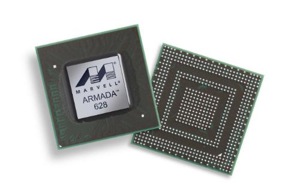Marvell debuts ARM chip for console graphics on a phone

Chip company Marvell has introduced a tri-core ARM-based system-on-chip processor with high-performance 3D graphics, aimed at smartphones, tablets and other mobile devices.
The Armada 628, announced on Thursday, combines two 1.5GHz ARM cores with an ultra-low-power third core that runs at 624MHz. This third core is intended to manage power and performance, as well as support routine user tasks.

The Armada 628, Marvell's tri-core ARM-based system-on-chip processor. Credit: Marvell
"[The] tri-core architecture is a unique solution to a long-time problem — how to achieve PC-class performance without breaking the limited power budget of smartphones, tablets and other mobile consumer devices," said Linley Gwennap, principal analyst of The Linley Group, in a statement issued by Marvell.
The chip has additional processing units for HD video encoding and decoding, audio, encryption, still-image processing and 3D graphics. The company said that the graphics processor can produce 200 MT/s (million triangles per second) from quad unified shaders. Its performance comes close to that of games consoles such as Sony's PlayStation 3, which can produce 250 MT/s.
No power consumption figures or costs were disclosed in the announcement, although Marvell predicted that the chip will play 10 hours of HD video and provide the equivalent throughput of a 3GHz processor for an hour on a single, unspecified charge.
Marvell has an ARM architecture licence, allowing it to modify ARM's core designs. It acquired Intel's Xscale ARM team in 2006, when Intel sold the unit off after deciding to concentrate on its own x86 Atom chips for the portable market.
The market for portable high-performance graphics designs has grown with the popularity of smartphones and the emerging market for tablets. Earlier this year, Nvidia announced Tegra 2, an system-on-chip (SoC) dual-core ARM design integrated with the chipmaker's first low-power GeForce GPU, specified to produce around 90 MT/s.